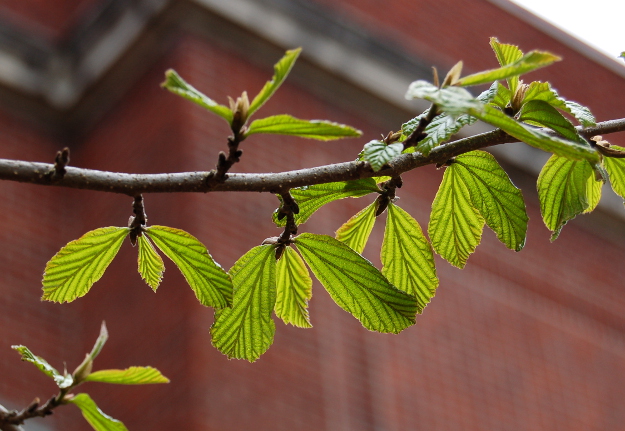
I’m a slow shopper. It takes me ten minutes to pick out five apples at the grocery store.
Now I’m trying to choose a tree for the parking strip, and that’s a major decision. I’ll have to live with it every day, you know?
Persian ironwood, or Persian parrotia (Parrotia persica), is on my shortlist, and I’m weighing the pros and cons. Do you know it?
Tops in fall color… or just meh
Parrotia is a small(ish) specimen tree in the witch hazel family. Like some other Hamamelidaceae members (witch hazels, fothergilla,) it’s known for its stellar fall color.

So here’s the thing. Parrotia can have psychedelic fall color.

It can be rich and bold.

Or more pastel, like rainbow sherbet.

But, unfortunately, it often just turns butterscotch-yellow. Which is nice, but once you’ve seen what the plant can do, you will want more than yellow.
You have to choose your plant in the fall to be sure what you’re getting. Even then, the color can vary year-to-year on the same plant.
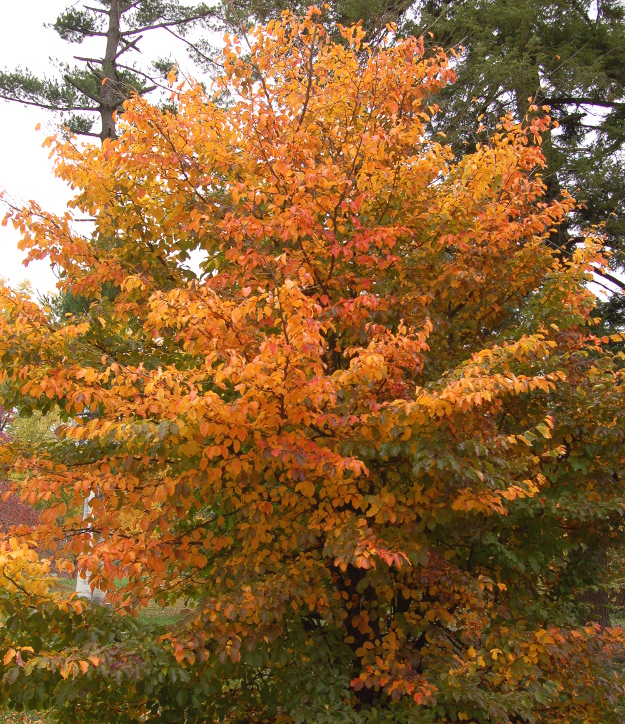
Here’s the same plant as the one above in a different year (and a couple weeks earlier in the season).
Licorice-red flowers
Persian ironwood blooms in late winter. Back in southwest Ohio, I would look for it to start around the first week of March, about the same time as red maple and cornelian cherry dogwood begin.
I assume it starts even earlier here in Portland, though I haven’t kept records. This year we’re behind schedule, so it’s hard to say when the average start time is.
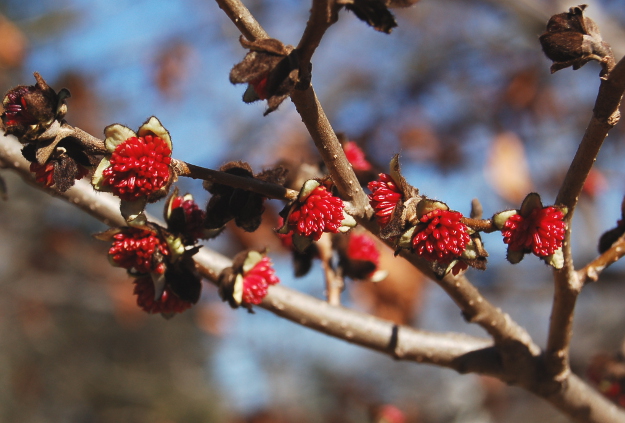
The dark brown, brushed-suede bud casings peel back to reveal the small flowers. The blooms have no petals.
The modest show is put on by waxy, licorice-red stamens shaped like slivered almonds.
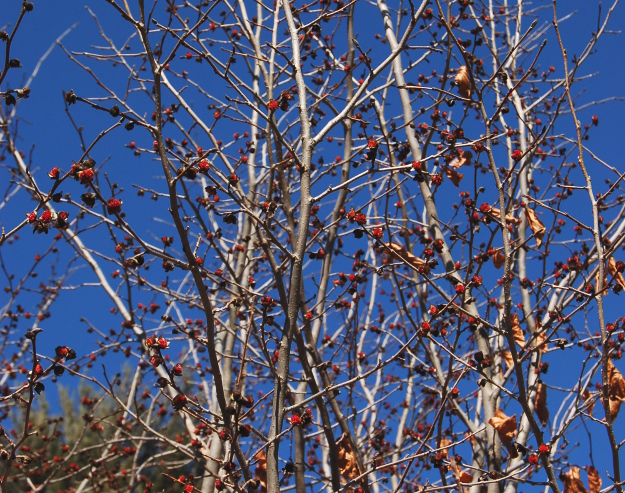
The show really is modest.
Some years in the Midwest the tree doesn’t bloom at all. That’s in zone 6. Parrotia flowers are probably more reliable here in zone 8b.
But even in a good year, the blossoms are tiny, and the color recedes.
On the other hand, what else is going on in early March? There isn’t much competition, and my flower-starved eyes are hungry for any harbinger of spring they can find.
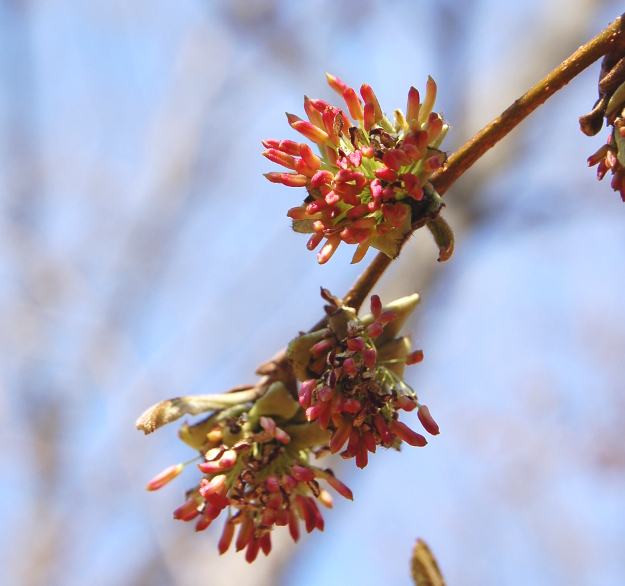
The flowers eventually expand, but the color fades.
Patchwork bark
Parrotia bark exfoliates in jigsaw puzzle–piece patches in time.
Some trees are spectacular, though often the claims about parrotia’s incredible four-season patchwork bark are overblown.
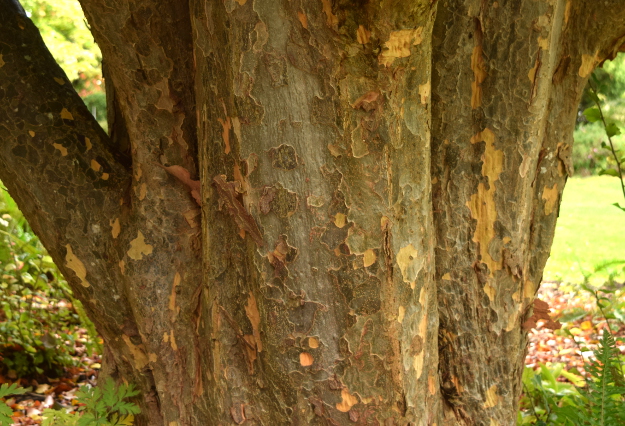
It takes forever for the process to start, and then some trees just aren’t as flaky as others. This one isn’t too shabby, but it’s the showiest section of an extremely old tree.
What’s with the name?
You may guess that parrotia was named for its colorful, parrot-like fall foliage. It was actually named after John Jacob Jingleheimer Schmidt Parrot.
Er, I mean Johann Jacob Friedrich Wilhelm Parrot. Friedrich “Fritz” Parrot was a German physician, physicist, naturalist, and mountaineer. He was the first westerner to climb Mt. Ararat, in what is now Turkey, in 1829.
Mt. Ararat was supposedly where Noah’s boat perched after the Flood. However, Parrot found no evidence of it.
And persica?
Persica refers to Persia. Parrotia hails from northern Iran, where it is endemic (only found in that small area).
A streetwise city tree
Parrotia seemed to me to be a connoisseur plant when I lived in the Midwest. It wasn’t very common, but those who knew their plants had one, and they gave it a honored spot in the garden.
So I was surprised when I came to Portland and saw parrotias everywhere—most notably, used as a street tree all around town.
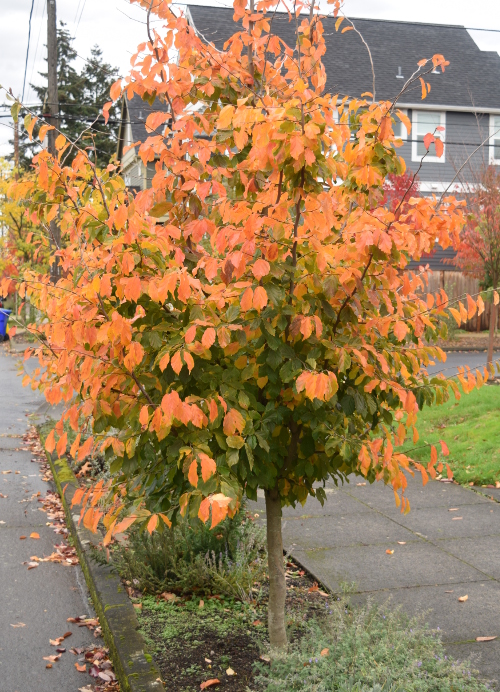
I didn’t realize it was such a tough tree. Indeed, it does handle harsh city growing conditions. The Society of Municipal Arborists named Parrotia persica ‘Vanessa’, a narrow form, their pick for 2014 Urban Tree of the Year.
It makes sense, after all, that a tree from Iran would be drought tolerant, but I found an interesting article from the Arnoldia by Robert Nicholson that described parrotia’s native habitat in some depth, and it wasn’t what I expected.
Nicholson said that parrotia inhabits the rainy side of the Alborz Mountains in Iran, a region that can receive 80 inches of rain per year!
The most that rainy Portland gets is 60 inches in the western hills. Lowland areas receive more like 40 inches per year on average.
To get 80 inches of rain, you’d have to go to the coast, and actually, Nicholson compares parrotia’s homeland climate to that of the northern California coast. The spring is dry, he says, and fall and winter are rainy.
So, it’s probably happiest in a northern California coastal climate, but this is still one tough plant.
Not such a small tree
Parrotia is often described as a small tree, but it’s more accurate to say that it remains a small tree for a long time.
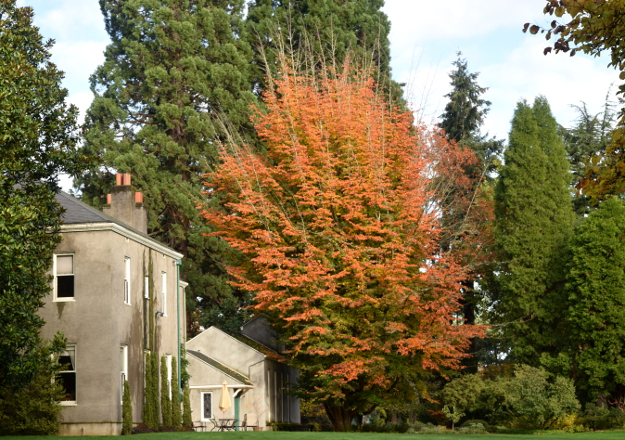
It can eventually get quite large, like this incredible plant at the Elk Rock Garden at the Bishop’s Close in Portland. (This is the tree from the bark photo.)
I’m guessing it’s 45 feet tall. Look at how tiny the patio furniture is next to it!
How to grow parrotia
Plant it green side up. This is a forgiving tree that anyone can grow. It is hardy to at least zone 5 (-20°F).
Make sure your soil has decent drainage.
Full sun will coax the richest fall color from the foliage, though part shade is acceptable.
Pests and diseases are generally of no concern, although in the East, Japanese beetles can be troublesome. Japanese beetles have only just arrived in Portland. Argh.
Although Persian ironwood is considered a slow grower, Michael Dirr, in his Manual of Woody Landscape Plants, indicates that trees can put on more than two-and-a-half feet of growth per year with proper feeding and irrigation.
What do you think?
Do you grow this tree or any of its cultivars? Do you love it, or do you have buyer’s remorse? Are you mad that I put that John Jacob Jingleheimer Schmidt song in your head? Please tell me in the comments!

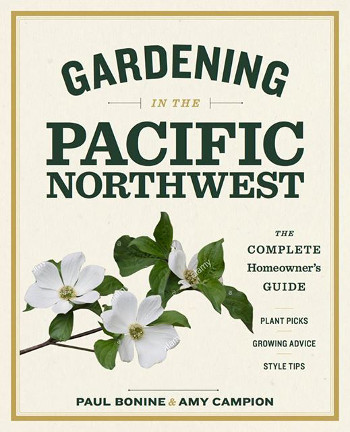























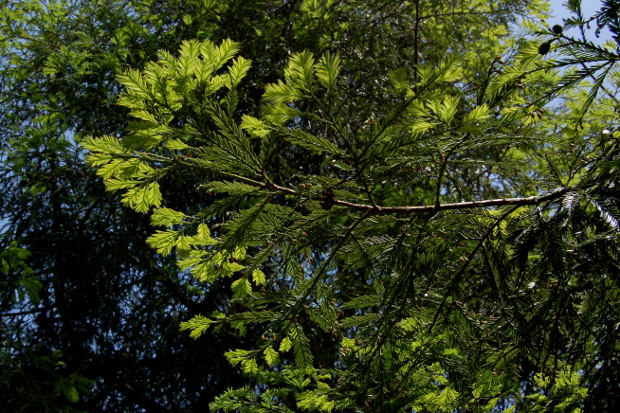


Love it ’cause it’s _not_ predictable 😉 Got a straight species from Lagergren 15 – 20 yrs ago and I don’t think any two Fall displays have been the same — giving me something to anticipate then ponder each year as I’m working on the final landscape chores.
The variability in bloom is another opportunity for pondering when out working on the earliest landscape chores — like H. vernalis & ‘Dawn’ viburnum, a true reward for being out in the cold, but not something the neighbors will ever notice. Mine didn’t bloom much this year, but I ran across one at Spring Grove that had several branches (but _not_ a majority) in heavy bloom.
City of Cincinnati is planting these curbside as well.
Nice. I can appreciate that point of view on both accounts. Good to know Cincy is planting these as street trees now!
I got one from Forestfarm (so it was pretty small) about 7 or 8 years ago for full sun in my central IN yard. Until last year, it pretty much just sat there. It does get stressed by drought and its smallest branches tend to die back when we don’t have rain for a month or more. But last year we had ample rain throughout the season and that little bush put on about 2′ of growth! This year, however, I’m going to need to cut off all but one its numerous trunks and turn it into a proper TREE. Back to tinyville for us . . .
The big tree in my photo has several trunks. Makes you wonder how tall it would be now if it had been trained to just one! Seems like this tree wants to be multi-stemmed.
I have ‘Vanessa’ in my garden and it grows well (northern Connecticut zone 5). A fast grower for me, at least in its youth. Fall color is completely different each year, sometimes none, sometimes russet, another year yellow. Very fickle. I never see them planted here, so it’s interesting to know they are common street trees in the northwest. Thanks for all this info on it — I’ve had a hard time finding much about this unusual (for here) tree.
I am thinking about ‘Vanessa’. I would have to plant something narrow for the spot it’s going in. Interesting that the color is so variable on a named variety. That makes it hard to decide! My neighbors have ginkgoes and that’s plenty of yellow. Thanks for your input.
Even though I still kinda wish we’d planted Paperbark Maples, I do like our Ironwoods. I don’t think they are the MOST amazing trees, but they are really tough now that they’re established (water well for the first 2-3 years). The flowers are not even worth mentioning, if you ask me. The fall color of ours is consistently peachy-yellow…but our neighbor across the street, who planted his at the same time, always has more reddish-burgundy coloring. Still, they are better than any of the oaks in our neighborhood, which mostly turn a dull yellow-brown…so I can’t complain! I do really like the branching…it’s very sinuous and elegant…especially nice in winter. Overall, I do think it’s a good street tree, tough, and with good 4-season interet.
They look good and seem to be happy in your clay soil. Yes, good point about the branching – it does have a sinuous look. Fall color is often disappointing on paperbark maples, too, anyway.
I’ve had my eye on that tree for years. It’s fabulous. I say, get it. Then I can enjoy it when I visit.
It is still a contender! We can always go visit the Bishop’s Close if I decide to get something else.
Overall love it for all the reasons stated.
Challenges:
– As stated not a small tree for long. We had 3 spaced 40′ apart when 20 years ago. Now down to 3 and soon to go to 1. In Wisely (UK) theirs, probably over 100 years old, a pretty massive tree.
– Architecture- 2 of ours are (were) almost droopy, 1 is vase shaped (really like this form) and 1 sort of has a spiraling 30′ tall leader. Don’t really want to droopier ones by a patio or on the road as you will have to keep pruning it up to keep out of the way.
– Seedlings. Not every year but in many years a lot of seedlings will germinate
under the tree and need to be removed… at least where gets irrigation.
– Juvenility- As with many oaks, in our Parrotia the closer to the crown the more juvenile. You see this with young oaks where the outer leaves turn color and drop long before the inner leaves. In the worst case scenario, the inner leaves hold on green while the outer turn and drop so you don’t get that all over color. After 20 years seems to coming around to pretty uniform color change.
Would plant again….
Hi Chad, I was going to mention how the outer leaves turn first and fall and you don’t get the full effect of all the leaves turning at once. You can even see it in the photo of the huge tree. That’s a bummer for sure.
The architecture could be problematic for me using it as a street tree. I would have to get a narrow form.
I’ve never seen seedlings! Wow. Definitely wouldn’t be a problem in the Midwest. I will start checking mature trees around Portland. Thank you for your comments!
Roger Gossler says it gets to be 80′ x 80′. I also was under the assumption that it was a “small ” tree and planted one about 10 years ago in an area of my yard that has its size limitations. Oops. I should have consulted with Roger first. I don’t have the heart to remove it so will wait and see what happens.
Oops. It’s hard to remove a perfectly healthy tree. Hopefully you can prune it and make it work.
They are planting these throughout my Beaverton, OR neighborhood. I wish they were choosing a native species instead…
I’m with you. Since I wrote this, I’ve gotten really into natives. Although, honestly it is really hard to find PNW natives that make good street trees. The list isn’t very long. At least for a narrow parking strip like mine.
It’s a handsome tree but seems to have some drawbacks. I think I’d lean toward a Katsura instead. Interested to see what you decide.
I love Katsura, but they need way too much water. I’m looking to water it rarely if ever after it’s established.
I have always loved this tree, er…at least since I was introduced to the one at Elk Rock Garden over 30 years ago. I have one today that is close to that age, a seedling from that same tree, that unfortunately is limited to the butterscotch yellow fall color you describe. Mine is maybe around 25′ tall. The flowers are often present by mid Feb., sometimes earlier, though later this year and often go unnoticed until we have one of those clear blue sky days when they stand out. My biggest issue with this is its tendency to sucker and sprout, a condition also that seems to vary from seedling to seedling. I remove them every year and am careful to limit my pruning of it so as not to stimulate more sprouting. Apparently ‘Vanessa’, the more upright clone, is not so ready to sprout, though I do see these occasionally in SE planted as street trees that do sucker and, often as not, the owners neglect to remove them. People also tend to not train these up, which is not unique to Parrotia, but because Parrotia can get relatively large over time, their trunks and main scaffold limbs can get quite large. If these remain low on the trunk this can become an issue as the whole tree gains girth. Such heavy physical mass at and around eye level is uncomfortable for pedestrians and such trees have considerably more ‘psychological’ mass than physical and people move away from them. But, still I love this tree, it is the oldest and largest tree in my garden…and, it’s staying.
I didn’t know your tree was a seedling of the Big One! That’s pretty cool. Yeah, the growth habit gives me pause for the place I want to plant it. It will be right next to the driveway, sidewalk, and street, so I don’t want any branches or suckers in the way. Thinking also about ‘Musashino’ zelkova, but zelkovas are already all over my neighborhood.
I live in Vancouver WA and planted a couple of Persian Ironwoods in my yard about 3 years ago. As to fall foliage, my experience matches what I have read from other people- the colors vary year to year. Mine haven’t bloomed at all, however, except for one tiny flower I noticed a couple weeks ago on one of the trees. I figured it might be a similar situation to lilacs which seem to require cold winters in order to bloom well. I noticed last spring the blooms on the lilacs in Eastern Oregon/Washington were spectacular, while mine were just so-so.
Does anyone know what conditions they require to bloom? Like most any plant I imagine I will have better luck getting blooms on them once they have gotten older and bigger. But mine are 6-7 feet tall and I was hoping they would have bloomed more by now.
Hi Lance, I think they just need to get a little older to bloom well. I don’t think cold winters help, because the trees in the Midwest often didn’t bloom at all that I observed. The cold can actually inhibit blooming. I believe it is just a maturity thing.
I think Parrotia trees are stunning!
I wish I could have one in my garden…
Well, hopefully there’s one nearby that you can admire at least. 🙂
Well, I think I never seen a Parrotia trees in my life but I think the one on your photos are really beautiful… I also really like how they can be unpredictable!
Or maybe you have seen one but didn’t know it??
It can be rich and bold.
When I saw this discussion, I had to add my two cents worth from Zone 5/6. About 20 years ago I read about parrotias and decided to order one. After I planted it, I found out that someone who ran one of our public parks had planted one at his home in north Columbus several years before I did (in Gahanna just east of Columbus). He was pleased with it, so that was a comfort to me. I agree completely about the variability of this beautiful tree! If I had kept notes on it, I could perhaps link its variability to specific reasons, but I didn’t expect to witness changes over the years. The ones that stand out are: one winter, it held its leaves until the following spring. I was afraid it was signaling its death, but no, it leafed out as usual in the spring. Another year the fall leaves on the shady side stayed green, which the sunny side turned rich gold. Fall colors vary greatly from year to year and often last a long time before dropping.
The foliage is unblemished, very thick and somewhat glossy. When I bought this tree, I was expecting a small tree, may 20 feet or so, but it is much taller and wider. It has done well in Central Ohio clay! (I lost two katsura trees in that soil, one quickly and the other after two years or so.)
Hi, we live in Australia…down the bottom where weather can be both extremely hot, and very cold. Hubby & I just bought a Persian Witch Hazel the other day. Our nieces planted it with him and we’re all now excitedly waiting to see what happens in the years ahead. Our little town (Steiglitz, in the state of Victoria) is a historic town. The last in Victoria without electricity, sewerage or town water. So irrigation is off our rain water tanks. Soil? Well, that’s almost rarer then rain…lol. Though our garden beds have taken nearly 25 years in the making, and seem offer all plants a good, rich base from which to thrive. Loved all your info. on what we can expect. It was a random, spontaneous choice at the time, so thankful for your site, which has eased my worries. Have a great day! With warm smiles from Steiglitz
Hi Lindy, I too have planted a Parrotia at Seaford in S. Aust. Loved the bronze edges on new foliage in spring. I have pale clay/sandy soils with lots of limestone about a km from the beach. Hot dry summers, cold wet winters and a short spring. Let’s see how this lovely tree copes with this. I have enriched the soil with compost and will water for the first couple of years. Doubt if it will reach giant proportions, but will make a nice tree anyway. Thank you everyone for your comments.
I live in Southern England UK zone 8b we have an ironwood which was here when we moved in nearly 30 years ago. It is now about 20ft high. We are on light clay soil. Colours vary with the type of weather we have had in the summer. From yellow to deep red and a wonderful mix in between.
It flowers early. Usually February when little else is bothering to wake up.
We often get a little bit of snow mid February and the dark bare branches with snow and the little red flowers are a joy to see I love it.
Sometimes my first indication it is flowering is the noise of humming in the garden. The flowers are a total magnet for any very early foraging bees that venture out on warm days. They absolutely love it. It has produced a couple of suckers over the years but certainly not a lot, maybe 3 or 4.
How lovely, my Parrotia is doing well in our conditions. butter yellow leaves in Autumn and although the new growth was burned on the edges in Spring when we had 44 degrees C in an unpleasant hot windy weather change in November, It is growing well and I have now had it in for 2 years. Looking forward to seeing flowers as it grows to maturity.
Well, three years on, the tree is still growing albeit slowly. Late spring the hot winds burn the edges of the leaves. Every spring… So I always have dry wrinkly edges on the leaves. I still love the new growth with its bronzy edges and if cut before the winds get it, the small cuttings last well in water as part of a flower arrangement.
I am stunned about the size of my Parrotia. It has totally outgrown its spot. I say spot and not a park where it should be located. The tree is a beauty, in every way.
But buyer be sure you know how much it can grow!
I love my parrotia, though I don’t know what variety it is. It is blooming for the first time after after planting, about 15 years ago. The flowers are insignificant so far, but still an exciting event. It is gorgeous in the Fall, bright multi colors. Karen in Olympia,Wa.
Thank you Amy for your article, I found it interesting.
I planted a mid-size parrotia 5 years ago and am satisfied with it, though I expected the foliage to be more dense. I think it’s a tree that’s not possible to prune at all, do you agree with me?
Regards,
Vince
I haven’t tried pruning a parrotia for density, but I think it could be done if you started early and did some light tip pruning on a regular basis.
We purchased a large potted specimen of an unusual parrotia with variegated leaves from a local (Connecticut, z6) nursery last season. It seemed to do okay but held on to its dead leaves since last fall and so far this March there have been no flowers and there are no buds in evidence. Twigs are green when cut, so I guess it is not entirely dead. Any insights or advice will be deeply appreciated.
Young trees usually don’t flower much, or at all, so that is no concern. Holding on to dead leaves may not be a problem either; young witch hazels (which are related) often do that, and it is no cause for alarm. Does it not have any leaf buds either? It should leaf out soon. If it doesn’t, perhaps it got too much water and the roots are compromised. Or it got too cold. Is it still in the pot? Trees are not as hardy in a container vs. in the ground.
Hi, and thank you so much for your insights. The tree was planted in the ground shortly after purchase. It was a strange summer: dry-wet-dry-wet. Then this winter was fairly mild but there were nutty cold spells and March saw a few snowstorms despite daytime highs in the 40s. I will post the condition of the tree for others to learn from if and when things change.
I planted a Persian Parrotia in a 1/2 wine barrel container 14 years ago and love it! It has one long leader and in total is about 20 feet tall, but that is mostly the leader alone. It has never flowered but that is no concern. It has the most beautiful, long-lasting rainbow of fall foliage and I’ve never had yellow only. Does anyone know if I need to prune the roots?
I came across this thread by chance looking for growing Parrotias in pots (UK) and your comment is the only one about growing them in containers I’ve found! So I’m really glad you posted this – I wasn’t sure whether to risk it so have now decided to do so. Many thanks!
Hi,
Thank you so much for all this information. I am in Chicago and looking to plant a tree on the south east side of the house in my small backyard. On the book parrotia persica ‘ruby vase’ seems like the perfect tree. Size is definitely important and it says 24-30ft tall, 15-18 ft wide. Those are the maximum dimensions my site can accommodate. Does any one have experience with the ‘ruby vase’ cultivar? It is supposed to be a little more vase shaped than the ‘Vanessa’. I found one in a local nursery, already 12ft tall. It is rather upright and very narrow. Could it still open up and how much?
We planted one in the side yard about 15 years ago, cultivar unknown, and it is now 25-30 feet tall, and a fine pyramidal shape. The leaves hang on all winter some years and fall early other years. It’s a very dense tree, good cover for birds. Unfortunately it’s one of those yellow-only fall color trees. We get an edge of hot pink on some leaves, but it’s not nearly as lurid as we had hoped. We might plant another one in the curb lawn, where all 3 big maples have been taken down, and hope for better color. Our weather here in Kalamazoo, MI, is zone 5 or 6 officially but it’s a bit warmer every winter. (There’s a Carolina Fringe Tree down the street that’s been praying for global warming for at least 50 years.) How salt-resistant are these trees, or does it matter much?
Hey Amy,
Did you ever get a Parrotia persica? I found them last week at Garden Frog Nursery for 50% off so I picked up a Parrotia ‘Persian Spire’ for $50. It’s over 6 feet tall already and doesn’t grow as wide as the straight species. If you’re interested I’d call the nursery and make sure the they still have one and they’re still on sale. Garden Frog is way out TV highway so it would be a long drive. Also snagged a 6′ Cornus kousa v. chinensis for $50. So many plants so little space.
No, I am thinking that I would rather get a pistache. I have never heard of Garden Frog, I’ll have to check it out!
Great post, Amy. I need to choose two new street trees to replace two thirsty red maples with uplifting roots. The main criteria are ‘smaller,’ narrow tree and drought tolerant. After hours of research I thought P. persica ‘Vanessa’ would be just the one. How great to read this informative blog post to see that it does have some supporters here in the Portland metro area.
But now you yourself say that you are considering a pistache. What happened?
I live on Delmarva (coastal Mid-Atlantic). I Parrotia from Gossler Farms (mail order) in 1994. It has grown into one of my favorite trees. It is a single trunk to 1.5′, then branches. It is now about 10″ caliper.The fall color is variable, but interesting. The best quality is its bark and I have limbed it up to make sure that it would be easy to see. It blooms every spring, but I have not observed seeds.
For me, the most interesting (and least often mentioned)characteristic is this plant is that it is ideal for greenery in flower arrangements. Most greens must be conditioned when cut to assure that they do not wilt in the arrangement–not so with Parrotia. I discovered this when I was pruning it in the late spring and left the trimmings lying on the ground, fully intending to return shortly to clean up the mess. A day later, the foliage still looked healthy. I’ve been using it in arrangements ever since.
I’ll be moving to a much larger property soon. I like this specimen so much that I am seriously considering hiring a spade truck to move it to the new property.
I love this tree, although not a small tree anymore. Fall color is spectacular and the structure of the tree in winter is beautiful. I live in Poulsbo, Wa.
UGA campus has three ironwood trees planted in an intersection triangle. They have done well there, so they are tough.
I planted one about 9 months ago, temperate maritime climate and despite summers of over 40 degrees C [104 F] and no rain [ hand watering]. the tree is thriving. Winters go down to single digit C temperatures with rain, so will see how it goes in it’s second year. Looking good so far.
We really love this tree now stationed in the middle of our front yard for around 5 years. The root system seems to be shallow but there is no evidence that surrounding lawn is adversely affected. The first summer after it was planted here in Michigan it proved to be a Japanese Beetle megamagnet. Subsequently I applied Bayer’s Tree and Shrub Liquid Fertilizer and Insect Treatment and have no longer had the problem.
I have 5 Persian Ironwood trees in my yard in Northeast Indiana, Zone 5b. Mail ordered the small bare root trees 10+ years ago from the now defunct Big Dipper Farm in Washington state. The three specimens in the shade have shown slow growth and subdued yellow fall coloring most years. The two specimens in full sun have shown vigorous growth, with the tallest now about 12 feet. The two in full sun also have beautiful deep red or maroon fall color most years, and one year even had what I would call a hot pink fall color. The leaf edges stay red all summer on most of my specimens. Very cold winters have caused some branch tip dieback but the trees have always bounced back. After a long display of fall color, the leaves eventually turn brown and stay attached most of the winter here. Frankly, I love the species. My largest specimen is the centerpiece of my front yard and I get questions and comments about it often.
I’m thinking of planting three of the Ruby Vase Ironwoods across the back fence in our small yard. I’m concerned about size, width & height, since the new yards are very small (30′ from fence to homes foundation) and I don’t want to have it grossly overrun the neighbors yard. I am also considering the Fireburst Paperbark Maple but need a tree that is a moderate grower so that I can have some privacy in our back yard sooner than later. Has anyone planted this variety and how tall & wide will it eventually get? I’m also concerned about the root system as we live in a windy area (I also do not want to cut suckers, had enough of that with the crabapple trees).
Our tree has been planted about 7 metres from the house. It was planted about 30 years ago, growing to about 5 metres high. It has no suckering at all and we are glad of that. The autumn foliage is fabulous and more spectacular than any of our other deciduous trees.
Our climate is cool temperate. Summer sees 30 degrees maximum and winter, zero on about 10 days only with daily maximum of 12 or 13 degrees. So our climate is perfect for us and our tree. Rainfall is about 720 mm per year which seems to be on the light side relative to its native area. Maybe that is why it has grown to only 7 metres in 30 years.
We are now considering giving it some judicious pruning to cut out some inward growing branches. Then after reading about this tree and how large it can grow we are considering regretfully taking it out altogether, being relatively close to the house. It is also only a metre from a low garden wall, so I have been watching to see if it cracks its foundations. If we take it out, we will be planting another. It seems to love its northern Tasmania home.
I have a 13 year old Vanessa. It’s always done so well but this year, when the new growth was trying to leaf out, the leaves shriveled, never grew beyond an inch or so in size, and some leaves turned black. It has tried to leaf out 3 times this spring and summer. Now, except for the bottom third of the tree, most of the branches have 8 to 12 inch tips that are bare. I have researched, communicated with the local extension office, called a couple of nurseries and had 2 tree specialists look at it but no one has any idea what is going on. Has anyone had this issue? If I treat it for fungus, should I use a copper or sulfur based fungicide. I don’t want to lose this beautiful tree! Any suggestions would be appreciated. Thank you.
Parrotias can certainly be estimable trees. I would encourage anyone, however, to buy a cultivar and lessen the risk of underwhelming fall color that attaches to many seed grown tree species. I favor Parrotia persica ‘JL Columnar’ sold under the TM Persian Spire. It’s a better size for most gardens, has strongly purple margined new growth and reliably contrasting fall color.
As to shape, the morphology of Parrotia persica here seems to contrast to those in their native range. The great English plantsman, Roy Lancaster, describes native stands of Parrotia in Iran with trees soaring on single or multiple trunks to 60′ with no squat forms in sight. (S Andrew monograph, “Tree of the Year: Parrotia” published International Dendrology Society 2007).
For those dissatisfied with their Parrotias, I would also encourage them to seek out the Chinese Parrotia, Parrotia subaequalis. This tree (or large shrub) only entered the commercial trade in the 1990’s. It is smaller leaved, faster growing, and at least as durable. Dirr reports that it colors reliably in Georgia and the PNW. My own is coloring now and is growing much faster than a comparable Parrotia persica. P. subaequalis can be hard to find, but Forestfarm Nursery in Williams, OR has sold this tree. It deserves, and I’m sure will find, a much wider audience in the US in coming decades. There are, as yet, no cultivars of this species. It is considered endangered in its native eastern China range. See, e.g. Yun-Yan Zhang et al: Development and Application of Genomic Resources in an Endangered Palaeoendemic Tree, Parrotia subaequalis (Hamamelidaceae) From Eastern China. Front. Plant Sci. 2018; 9:246.
Hi Bruce,
I was considering the cultivars ‘Ruby Vase’ and ‘Vanessa’, but now after reading your post about ‘Persian Spire’ and the Chinese Parrotia, I’m wondering if I should reconsider. Having reliable red/orange fall color is important to me. I’d be disappointed if the tree only had yellow leaves as many have reported.
Of the four, do you know:
1. Which most reliably has red/orange fall colors?
2. Grows the fastest?
3. Which is most amenable to being trained into a single trunk tree?
I’m in the SF Bay Area, Sunset Zone 15.
Thanks so much for your informative post!
Pearl
Hi Bruce, (and Pearl, and everyone else!) What an interesting discussion! I’m intending to plant some trees in Spring 2021….and am hoping for good shape and good fall color (and any other bonuses!). Parrotia is now on the list! Acid soil, zone 8b (east of Seattle), 10 ft. away from a greenhouse…(NW of green house). There is a multi-trunk Parrotia down the street from me – but until I read this…I didn’t know what it was. Thanks for the education, the advice, and the ‘new’ tree introduction. Hope everyone has a really good New Year in 2021.
Thank you for your description of P. Persica. I saw it in flower in Antwerp, Belgium, botanical garden in flower yesterday and being from Iran was immediately taken by thd naming. Tried to find out how if was named after Parrot family. Wikipedia says it was named after Georg Parrot who botanised in Alborz mountains (assuming he was tgd first to find it) but it seems it was named after Georg’s son Friedrich Parrog who conquered mount Ararat. No idea if it grows there but is endemic oc wetter Alborz mountains. Any ideas?
Hi
At least how much temperature it can withstand?
I have Parrotia persica and I love it. My tree is probably 30 years old and has just started exfoliating it’s bark (at first I thought there was something wrong with it). The only problem I have with it is that it sends up suckers around the base. Not sure if that’s a trait or if I did something wrong when I planted it. The color is phenomenal in the fall. Orange, hot pink, cherry red….it ALWAYS puts on an amazing show.
I also have the Vanessa variety and, although it’s color isn’t as spectacular (the butterscotch colors), it’s still a great tree.
Planted two at a farm in upstate NY in 2003, and lost both the next year. The nursery where I bought them stopped selling them because of customer complaints that they couldn’t survive the winter. Planted four more a suburban home in Albany in 2011, and lost two more the first year out. But two were spectacular. With regular watering and feeding, each grew well over 2 feet per year, and the bark started to exfoliate and show multi-colors after about 5 years. Both that survived handled pruning quite well – heavy pruning. Moved back to the country in 2020, and planted two more in late spring 2021. Large B&B specimens. It is now May 18, 2022 and I fear that neither will make it. Temperatures this winter never went much below 0, but it was a bit on the dry side. Am very surprised at this turn of events. I am used to trees, particularly large trees, going through an extended period of little growth due to transplant shock. Both of my parrotia persica were fabulous in the months after planting. Lots of growth and beautiful orange-red fall color. So this spring has been confusing. Both are in some shade, and I have to report that the one in more sun is trying to put out leaves. I am rather heart broken. When conditions are right and these trees have a year or two under their belt, they are tough and fabulous. But I am having trouble getting to the second year. For those who might be wondering, over the last thirty years, I have planted well over a thousand trees, and almost never lose one. But both Persian ironwood and Franklin trees have been frustrating. As a sidebar, a well grown Franklin tree may have the best fall color of any tree that I have planted. As for bushes, nothing beats the fall color of a Grace smokebush. For early fall color, go with a three flower maple. Small, beautiful form, and the bark is quite interesting in that it shreds. But the early fall color is an electric red orange.
Hi Amy. I live in western Massachusetts. I have a 9 foot tall ‘Vanessa’ Parrotia that needs to be moved to another part of my yard. Do you know if Fall or Spring is best for moving? Thank you!
Bought the Persian Ironwood Vanessa and planted it two days ago here in Nottingham UK. Seen it a few years ago in a 5 litre pot about 5 feet high looking all colourful in Autumn. It was around 8 feet high when I spotted it at the same garden centre again along with two others. The Autumn colours at the moment are purple, red, orange, yellow, lime and a pinkish orange. I put it in my South facing front garden and dug a lot of ericaceous into the planting hole, as it loves acid soil apparently. So far so good and it is really brightening up the front at about 7 feet high. We don’t have a problem with rain here, but I’ll water it once or twice a week the first year when the ericaceous mulch around it dries out. I’ve had my eye on this tree for many years and glad I finally bought one. I’ll keep you posted next year on how it’s doing.
Hello! We just planted our Parrotia Persica Ruby Vase today! We are in Portland, Oregon as well, and just happened upon this one at the nursery.
During the ice and wind storm that we had a few months ago, our neighbor lost his tree (which was an exotic specimen from so. America, but I can’t remember which), it nearly knocked over our fence, but thankfully I only have to replace one section!
Anyways, his tree provided some good shade, and we are hoping ours grows quickly to fill in the void left when the neighbor’s tree toppled .
It’s currently 8’ tall with zero leaves and zero flowers. We planted it in heavy clay soil.and it’s always really moist, so I’m hoping that means we will get that 2’ of growth per year! Because as I said, we lost our shade when the neighbors tree fell.
I will report back with additional details as they warrant. Cheers!